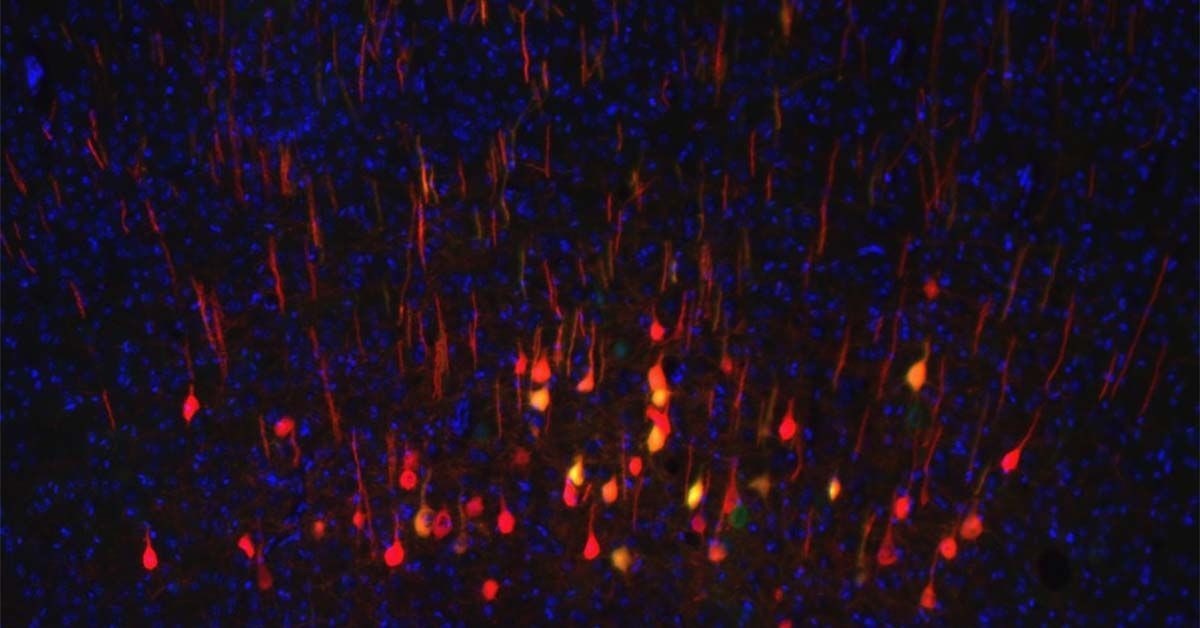Reviewed by Danielle Ellis, B.Sc.Oct 17 2023
The primary cells that make up our brain and spinal cord, called neurons, are among the slowest to heal after injury, and many neurons never fully recover. Although research into neural regeneration has advanced, it is still unclear why certain neurons recover while others do not.
 Neurons, shown here in red and yellow, are some of the slowest cells to regenerate after injury. In this section of a mouse brain, yellow neurons are regenerating while red neurons are non-regenerating. Image Credit: University of California, San Diego
Neurons, shown here in red and yellow, are some of the slowest cells to regenerate after injury. In this section of a mouse brain, yellow neurons are regenerating while red neurons are non-regenerating. Image Credit: University of California, San Diego
Researchers at the University of California San Diego School of Medicine have discovered a novel biomarker that could be used to predict whether or not neurons can recover after an injury. This biomarker was discovered using single-cell RNA sequencing, a technique that identifies which genes are active in individual cells.
They placed their discovery to the test in mice and discovered that the biomarker consistently worked in neurons throughout the nervous system and at various stages of development. The research was released in the journal Neuron on October 16th, 2023.
Single-cell sequencing technology is helping us look at the biology of neurons in much more detail than has ever been possible, and this study really demonstrates that capability. What we have discovered here could be just the beginning of a new generation of sophisticated biomarkers based on single-cell data.”
Binhai Zheng, PhD, Study Senior Author and Professor, Department of Neurosciences, School of Medicine, University of California, San Diego
The corticospinal tract, a vital component of the central nervous system that aids in movement regulation, was the area on which the researchers concentrated. The long, thin structures called axons, which neurons use to communicate with one another, are among the least likely to recover in these neurons after damage. The severe effects of brain and spinal cord injuries are due to this.
If you get an injury in your arm or your leg, those nerves can regenerate and it’s often possible to make a full functional recovery, but this is not the case for the central nervous system. It is extremely difficult to recover from most brain and spinal cord injuries because those cells have very limited regenerative capacity. Once they are gone, they are gone.”
Hugo Kim, PhD, Study First Author and Postdoctoral Fellow, University of California, San Diego
The researchers examined gene expression in neurons from mice with spinal cord injury using single-cell RNA sequencing. Using well-known molecular methods, they induced the regeneration of these neurons, although ultimately, only some of the cells were successful. The researchers were able to compare the sequencing data from neurons that were regenerating and those that were not, thanks to this experimental setup.
Additionally, by concentrating on a very small number of cells—just over 300—the researchers were able to examine each individual cell in great detail.
Zheng added, “Just like how every person is different, every cell has its own unique biology. Exploring minute differences between cells can tell us a lot about how those cells work.”
The researchers found a distinct gene expression pattern that can predict whether or not a certain neuron can ultimately recover after an injury using a computer algorithm to assess their sequencing data. Some genes that have never before been connected to neuronal regeneration were also part of the pattern.
“It is like a molecular fingerprint for regenerating neurons,” Zheng noted.
The researchers used 26 published single-cell RNA sequencing datasets to assess this molecular fingerprint, which they called the Regeneration Classifier, to confirm their findings. These datasets contained neurons at distinct developmental stages and from diverse regions of the nervous system.
With just a few exceptions, the researchers discovered that the Regeneration Classifier accurately predicted each individual neuron’s capacity for regeneration and was able to mimic established patterns from earlier studies, such as a dramatic decline in neural regeneration immediately after birth.
Zheng stated, “Validating the results against many sets of data from completely different lines of research tells us that we have uncovered something fundamental about the underlying biology of neuronal regeneration. We need to do more work to refine our approach, but I think we have come across a pattern that could be universal to all regenerating neurons.”
Despite the positive results in mice, the researchers stress that the Regeneration Classifier is now more of a tool for neuroscience researchers in the lab than a diagnostic test for people.
“There are still a lot of barriers to using single-cell sequencing in clinical contexts, such as high cost, difficulty analyzing large amounts of data and, most importantly, accessibility to tissues of interest. For now, we’re interested in exploring how we can use the Regeneration Classifier in preclinical contexts to predict the effectiveness of new regenerative therapies and help move those treatments closer to clinical trials,” Zheng concluded.
Source:
Journal reference:
Kim, H. J., et al. (2023). Deep scRNA sequencing reveals a broadly applicable Regeneration Classifier and implicates antioxidant response in corticospinal axon regeneration. Neuron. doi.org/10.1016/j.neuron.2023.09.019